
About UsThe Numismatic Bibliomania Society is a non-profit organization devoted to the study and enjoyment of numismatic literature. For more information please see our web site at coinbooks.org SubscriptionsThose wishing to become new E-Sylum subscribers (or wishing to Unsubscribe) can go to the following web page link MembershipThere is a membership application available on the web site Membership Application To join, print the application and return it with your check to the address printed on the application. Membership is only $20 to addresses in the U.S., $25 for First Class mail, and $30 elsewhere. For those without web access, write to: Terry White, Treasurer
AsylumFor Asylum mailing address changes and other membership questions, contact Terry at this email address: terrywhite5475@yahoo.com SubmissionsTo submit items for publication in The E-Sylum, just Reply to this message, or write to the Editor at this address: whomren@gmail.com BUY THE BOOK BEFORE THE COINSale Calendar |
- WAYNE'S WORDS: THE E-SYLUM OCTOBER 18, 2015
- AUCTION CATALOGS FOR SALE (THE GRADY HOARD)
- NEW BOOK: LOST AND FOUND COIN HOARDS AND TREASURES
- NEW BOOK: 2016 STANDARD CATALOG OF WORLD COINS 1901-2000
- NEW BOOK: VIRGINIA TOKENS, 2ND EDITION
- NEW BOOKS FROM THE AMERICAN NUMISMATIC SOCIETY
- EGYPTIAN NATIONAL LIBRARY COLLECTION PUBLISHED ONLINE
- MORE ON PRESS RUNS OF NUMISMATIC BOOKS
- THE JOHN ADAMS COLLECTION OFFERED BY STACK'S BOWERS
- PAUL REVERE SPOONS IN UPCOMING SALE
- NOTES FROM E-SYLUM READERS: OCTOBER 18, 2015
- LATEST IN THE 1933 $20 GOLD CASE
- 1933 $20 GOLD CASE: ENOUGH ALREADY
- PETER MCTAGGART (1732-1825+)
- ANS LIBRARIAN, A.H. COOPER-PRICHARD
- THE U.S. DIPLOMATIC MEDAL
- U.S. DIPLOMATIC MEDAL RESEARCH MATERIALS
- ORIGINAL BANDED FRACTIONAL PACKS
- THE INTERNATIONAL NUMISMATIC CONGRESS
- WAYNE'S NUMISMATIC DIARY: OCTOBER 18, 2015
- TRIBUTE TO CCAC MEMBER GARY MARKS
- STATE EDITORS SOUGHT FOR PAPER MONEY ENCYCLOPEDIA
- NEW CONCEPTS IN COINS AND MEDALS: FAD OR FASHION?
- SELECTIONS FROM SINCONA BANKNOTE AUCTION #27
- TWO VIDEOS ON COIN RESTORATION
- HOLLINBECK COIN SHOPS COIN BOARD STAMPS
- REBUS PUZZLE: FORDHAM'S, MONTROSE, PA
- ARCHIE'S PLACE DISPLAYS BANKNOTE COLLECTION
- FEATURED WEB PAGE: NUMISMATICA ITALIANA
Click here to access the complete archive
To comment or submit articles, reply to whomren@gmail.com
WAYNE'S WORDS: THE E-SYLUM OCTOBER 18, 2015

New subscribers this week include: Jon Sullivan. Welcome aboard! We now have 1,887 subscribers.
This week we open with an auction catalog sale and six new books. Other topics include coin hoards, the 1933 double eagles, Peter McTaggart, A.H. Cooper-Pritchard, Gary Marks, the U.S. Diplomatic medal, coin restoration, and the Hollinbeck coin board stamps.
To learn more about Roman architecture on coinage, the John W. Adams collection, the Yoachum Dollar, fractional currency bands, Tinkling, Virginia, hyperdimensional medals, peacocks and turkeys, read on. Have a great week, everyone!
Wayne Homren
Editor, The E-Sylum
AUCTION CATALOGS FOR SALE (THE GRADY HOARD)
(Former) numismatic literature dealer Orville Grady writes:
I wanted to let readers know I’m retiring from the book business, have sold all the book inventory, and only have the auction catalogs remaining. The physical size of the group is two racks 12 feet long, 6 feet high, 18 inches wide, 6 shelves in each rack. The catalogs should be able to fit it in a 10 foot panel van. About half of the catalogs are already boxed and labeled with the auction firm noted on the box. My asking price is $4500 for the lot.
The majority of the catalogs are US sales, around 70 to 80% or so, even though the listing will not reflect that. There are multiples of most of the US catalogs and of a lot of the foreign sales, a total of nearly five thousand catalogs. The listing is not comprehensive since there are many catalogs not in the data base (for example the Bowers Armand Champa sale of 1982, around 6 copies, around 40 Ford sales etc, etc). I will send a list to anyone interested upon request. If you wish to discuss, inspect them or have any questions feel free to phone. Thanks, Orville Grady (402-721-8348)
NEW BOOK: LOST AND FOUND COIN HOARDS AND TREASURES
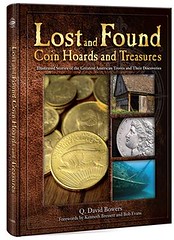 Whitman Publishing announces the release of Lost and Found Coin Hoards and Treasures: Illustrated Stories of the Greatest American
Troves and Their Discoveries, by Q. David Bowers. The 480-page hardcover book will debut on October 27, 2015. It is available from booksellers
and hobby shops nationwide, and online (including at www.Whitman.com), for $39.95. The book can also be borrowed for free as a benefit of membership
in the American Numismatic Association, through the Dwight N. Manley Numismatic Library.
Whitman Publishing announces the release of Lost and Found Coin Hoards and Treasures: Illustrated Stories of the Greatest American
Troves and Their Discoveries, by Q. David Bowers. The 480-page hardcover book will debut on October 27, 2015. It is available from booksellers
and hobby shops nationwide, and online (including at www.Whitman.com), for $39.95. The book can also be borrowed for free as a benefit of membership
in the American Numismatic Association, through the Dwight N. Manley Numismatic Library.
Lost and Found Coin Hoards and Treasures details the most significant finds of American coins from the colonial period to the modern day. Whether the accumulations were created intentionally (perhaps by a miser who distrusted banks, or by a savvy numismatist) or unintentionally (buried by thieves but never dug up, or lost in a tragedy at sea), their remarkable discoveries will interest coin collectors, treasure-seekers, and everyone else who enjoys tales of lost fortunes that are found again.
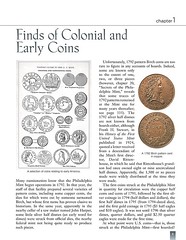 Q. David Bowers is one of America’s master storytellers. “My new book shines light on the most dramatic and unusual American coin hoards
and treasures,” he said. “You will be astounded by their stories, and might be inspired to do some hunting of your own.”
Q. David Bowers is one of America’s master storytellers. “My new book shines light on the most dramatic and unusual American coin hoards
and treasures,” he said. “You will be astounded by their stories, and might be inspired to do some hunting of your own.”
“Many treasures have already been found; many others are waiting for someone to find them,” said Whitman publisher Dennis Tucker, who also notes that every story inside the book is true. “Bowers shares tales of treasure from sunken ships, bank vaults and reserves, hidden compartments, buried chests and boxes, hiding places of pirates and privateers, old cornerstones, barrels and casks, U.S. Mint storage, wrecked buildings, caves and crevices, ancient estates, dusty time capsules, forgotten collections, attics, basements, and other lost and hidden places.”
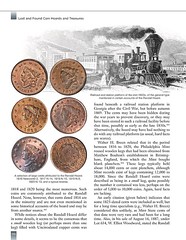 Bowers gives rich historical context for every find. Some of the personalities he introduces are quirky, like coin hoarder Alexander
Miller, who lived in a tiny town in Vermont, rarely spoke with the outside world, and also collected airplane parts and vintage cars. Some are
courageous, like Captain William Lewis Herndon, who went down with the hurricane-stricken treasure ship SS Central America after evacuating the women
and children.
Bowers gives rich historical context for every find. Some of the personalities he introduces are quirky, like coin hoarder Alexander
Miller, who lived in a tiny town in Vermont, rarely spoke with the outside world, and also collected airplane parts and vintage cars. Some are
courageous, like Captain William Lewis Herndon, who went down with the hurricane-stricken treasure ship SS Central America after evacuating the women
and children.
Lost and Found Coin Hoards and Treasures also includes a state-by-state listing of treasures waiting to be found; a detailed review of the Great Treasury Hoard for Morgan dollar collectors; a chronological listing of notable shipwrecks yet to be salvaged; and an examination of 26 hoaxes, fantasies, and questionable finds. The book is richly illustrated with more than 600 full-color images. Bowers inventories the Donner Party find, the Cogswell time capsule, the Massachusetts State House cornerstone, the hoard of miser Aaron White, the Baltimore Hoard of gold coins, the wrecks of numerous treasure-laden ships, and many dozens of other finds.
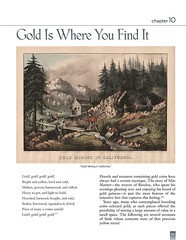
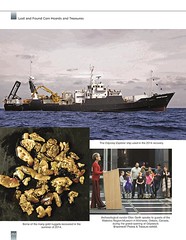
Lost and Found Coin Hoards and Treasures: Illustrated Stories of the Greatest American Troves and Their Discoveries, by Q. David Bowers; forewords by Kenneth Bressett and Bob Evans. ISBN 0794842933 ● Hardcover, 8.5 x 11 inches, 480 pages, full color ● Retail $39.95 U.S.
For more information, or to order, see:
Lost and Found Coin Hoards and
Treasures (www.whitman.com/store/Inventory/Detail/Lost-and-Found-Coin-Hoards-and-Treasures+0794842933)
NEW BOOK: 2016 STANDARD CATALOG OF WORLD COINS 1901-2000
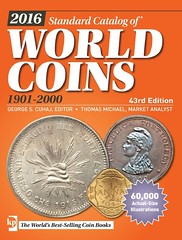 2016 Standard Catalog of World Coins 1901-2000
2016 Standard Catalog of World Coins 1901-2000
43rd Edition
The Standard Catalog of World Coins, 1901-2000 is a leading authority in world coin prices and referencing. If you are a world coin collector, this is the must-have guide to all coins found in the world during 1901-2000. This catalog has offered 40 years of the most reliable information on 20th century coins available on the market.
This book is for any coin collector from beginner to expert. It is the number one tool for world coin dealers and researchers. No other reference exists which embodies the detail and comprehensive coverage of this catalog.
You'll Find These Key Features in This Brand-New Guide:
- Hundreds of updated coin images and information
- 2,000 pages of the most up-to-date information on world coins
- 60,000 actual-size images of world coins for easy identification and current market values in up to 5 grades
- Information given by George S. Cuhaj and Thomas Michael, who are longtime and highly respected experts in the field
- And much more!
For more information, or to order, see:
2016 Standard Catalog
of World Coins 1901-2000 (www.shopnumismaster.com/2016-standard-catalog-of-world-coins-1901-2000?et_mid=789672&rid=238176646)
NEW BOOK: VIRGINIA TOKENS, 2ND EDITION

In 1980, David Schenkman’s Virginia Tokens was the first work to document the trade tokens from the Commonwealth and helped set the standard for state token catalogs nationwide.
Now, 35 years later, the second revised edition is ready.
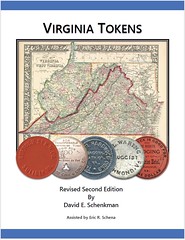 Tokens in Virginia have a long and distinguished history and offer the exonumist a wide spectrum of specialties. From Hard Times store
cards, transportation tokens dating back to the 1860s, coal scrip, to trade tokens and picker’s checks, Virginia Tokens seeks to document the many
varied aspects of exonumia throughout the state in a convenient and easy to use format.
Tokens in Virginia have a long and distinguished history and offer the exonumist a wide spectrum of specialties. From Hard Times store
cards, transportation tokens dating back to the 1860s, coal scrip, to trade tokens and picker’s checks, Virginia Tokens seeks to document the many
varied aspects of exonumia throughout the state in a convenient and easy to use format.
With nearly 6,000 different tokens listed from roughly 2,250 different merchants located in approximately 770 towns, the new 2015 revision more than doubles the number of known listings from the original catalog. The revised second edition includes an expanded introduction that features a history of tokens in Virginia, as well as details on several of the principal token manufacturers. In addition, tips on collecting will benefit both long-time specialists as well as novices to the field.
The catalog also features hundreds of full-color illustrations throughout, of not only the tokens but also related images that add to the historical interest and flavor of the pieces. Rounding out the book is a comprehensive index of merchants that will help collectors to quickly identify mavericks.
In addition to Virginia Tokens, David E. Schenkman has authored seven other token catalogs, including Merchant Tokens of Washington, D.C., Maryland Merchant Tokens, and recently (in 2009) West Virginia Merchant Tokens, all of which have become standard works. Schenkman has been a prolific writer throughout his numismatic career, serving as editor of the Token and Medal Society’s TAMS Journal from 1982 to 2010, a task that included editing all the books published by that organization during that time. The second edition of Virginia Tokens continues in this fine tradition of ground-breaking research and will no doubt become an influential work on merchant tokens for years to come.
The catalog was successfully released at the Virginia Numismatic Association’s 57th Convention & Coin Show held September 25-27, 2015 at the Fredericksburg Expo & Conference Center in Fredericksburg, Virginia. In addition to its enthusiastic reception by convention attendees, Virginia Tokens is now available for sale through the VNA. The book is priced at $75 with a discount for VNA members. For more information on the Convention and book ordering, please contact the Virginia Numismatic Association or visit VNA’s website at www.vnaonline.org.
To read the complete article, see:
VNA Releases 2nd Edition of
Schenkman’s Catalog of Virginia Tokens (www.coinweek.com/coin-clubs/vna-releases-2nd-edition-schenkmans-catalog-virginia-tokens/)

NEW BOOKS FROM THE AMERICAN NUMISMATIC SOCIETY
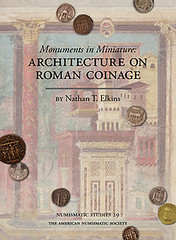 Three new publications are scheduled to go to press next month and be delivered by the end of the calendar year, appealing to wide
audiences. For those interested in Roman history, architecture, or general numismatics, Monuments in Miniature by Nathan Elkins is about Roman
architecture featured on coinage of the Roman Empire. Irritamenta: Numismatic Treasures of a Renaissance Collector, a two-volume set by John
Cunnally, will grab the interest of historians, numismatists, Renaissance scholars and art historians with its reproduction of a 300-page manuscript
of hand-drawn coins and a 1,200 coin catalogue. Michael Bonine’s work, The Banknotes of the Imperial Bank of Persia, highlights the large and
colorful banknotes used in Iran in this short and full-color book.
Three new publications are scheduled to go to press next month and be delivered by the end of the calendar year, appealing to wide
audiences. For those interested in Roman history, architecture, or general numismatics, Monuments in Miniature by Nathan Elkins is about Roman
architecture featured on coinage of the Roman Empire. Irritamenta: Numismatic Treasures of a Renaissance Collector, a two-volume set by John
Cunnally, will grab the interest of historians, numismatists, Renaissance scholars and art historians with its reproduction of a 300-page manuscript
of hand-drawn coins and a 1,200 coin catalogue. Michael Bonine’s work, The Banknotes of the Imperial Bank of Persia, highlights the large and
colorful banknotes used in Iran in this short and full-color book.
For more information when available, see:
http://numismatics.org/Store/Store
EGYPTIAN NATIONAL LIBRARY COLLECTION PUBLISHED ONLINE
 The American Numismatic Society is pleased to announce the digital publication of the non-hoard numismatic collection of the Egyptian
National Library (http://enl.numismatics.org), in collaboration with Dr. Jere Bacharach, Professor Emeritus,
Department of History at the University of Washington, and Dr. Sherif Anwar, College of Archaeology, Cairo University.
The American Numismatic Society is pleased to announce the digital publication of the non-hoard numismatic collection of the Egyptian
National Library (http://enl.numismatics.org), in collaboration with Dr. Jere Bacharach, Professor Emeritus,
Department of History at the University of Washington, and Dr. Sherif Anwar, College of Archaeology, Cairo University.
The catalogue consists of more than 6,500 numismatic objects, ranging from late Roman glassware and pre-Islamic Sasanian coinage to the modern Egyptian coinage of Anwar Sadat and is particularly strong in Medieval Islamic coinage across all major dynasties. The collection has been photographed in color, and the interface is available in both English and Arabic. Geographic coordinates have been included for the majority of Islamic mints, permitting the mapping of the Egyptian National Library collection. Learn more about this exciting new collaboration.
To view the collection online, see:
Dar al-Kutub Collection of the Egyptian National Library. (http://enl.numismatics.org/)
For more information on the project, see:
ANS Launches Online Catalogue with Dar al-Kutub, the Egyptian National Library
(http://numismatics.org/NewsEvents/Egypt)
MORE ON PRESS RUNS OF NUMISMATIC BOOKS
A few observations on Dave Lange’s informative contribution:
1) "I printed 300 of this title, which was the minimum figure for an established printer that was known to do work of the quality I demanded.”
The 300 print run makes sense as far as unit cost is concerned but most any quality printer will print fewer if the author/publisher is willing to pay a higher price per copy, i.e., the 300 copy price, less paper and binding costs (press time and ink costs are negligible).
2) "One thing I've noticed is that book sales for both my own titles and the more popular titles of commercial publishers in the numismatic field haven't recovered from the 2008-09 recession.”
While I basically agree with Dave, it is also true that an astonishing number of new numismatic works continue to be published worldwide. Further, the success of Whitman Publishing in recent years is even more astonishing. Anyone who has seen their booth at a major coin show or perused their publications online cannot fail to be impressed. An estimable contingent of talented authors and the firm’s outstanding marketing program, combined with hefty print runs, enable Whitman to sell well written, well produced books at insanely reasonable prices.
3) "One thing weighing in favor of smaller press runs is that modern printing technology can produce quality works at a reasonable cost that is not necessarily related to the number of copies ordered.”
I have no experience with “print on demand” services but “quality” of illustration still appears to be a key factor in the unit price cost of small print runs in my experience. This is particularly where illustrations are produced by stochastic or fine line offset printing methods.
To read the earlier E-Sylum article, see:
THOUGHTS ON PRESS RUNS OF NUMISMATIC BOOKS
(www.coinbooks.org/esylum_v18n41a07.html)

Archives International Auctions, Part XXIX
U.S. & Worldwide Banknotes, Scripophily, Coins,
Historic Artifacts & Ephemera, Artwork, Autographs
and Security Printing Ephemera
October 24th & 29th, 2015

Click the links! Highlights include:
- Lot 26: Thomas Spencer - Honolulu - Sandwich Islands 1858
- Lot 320: Accelerating Steam Navigation Co. 1841 Ten shares
- Lot 363: Confederate States Bond. $10,000. Cr.146, B-339.
- Lot 413: First Liberty Loan Converted 4 _% Gold Bond of 1932-1947
- Lot 607: Fijian Government Debenture, 1872 Issue
- Lot 715: Bono De Caja, El Banco Comercial Refaccionario De Chihuahua
- Lot 738: Banco Nacional Del Peru, 1877 Provisional Issue Specimen
- Lot 809: Bank of Zambia, ND (1964) Specimen Banknote.
- Lot 948: British American Bank Note Company Engravers & Printers Proof
- Lot 960: Draper, Underwood, Bald & Spencer, ND, ca.1820's Sample Sheet.
- Lot 1000: Colonial Pennsylvania, 15 Shillings 5.20.1758.
- Lot 1056: Cherokee Insurance & Banking Co. 2 Dollars. 1862.
- Lot 1139: Bank of America, 1879 Specimen $10,000 Clearing House Certificate.
- Lot 1148: Manufacturers Bank, 184x Proof Banknote on a Proof Vignette Sheet
- Lot 1229: Confederate States. 5 Dollars. 1861.
- Lot 1280: Legal Tender Note. 1863 Series. 5 Dollars.
- Lot 1298: Hackettstown National Bank of NJ., Second Charter $10.00
View the Virtual Catalog
Download the Catalog in PDF format
ARCHIVES INTERNATIONAL AUCTIONS, LLC
1580 Lemoine Avenue, Suite #7
Fort Lee, NJ 07024
Phone: 201-944-4800
Email: info@archivesinternational.com
WWW.ARCHIVESINTERNATIONAL.COM
THE JOHN ADAMS COLLECTION OFFERED BY STACK'S BOWERS
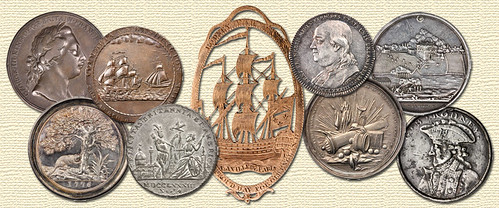
More than three decades after the name John W. Adams first appeared on the cover of one of our publications, we are honored to again offer rarities from the collection of this legendary scholar and numismatist. In 1982, Mr. Adams selected Bowers and Ruddy Galleries to offer a unique collection of 1794 cents, a grouping collected with connoisseurship based not only upon condition and rarity, but also each coin’s lengthy and well-documented provenance. Adams’ love affair with history has made him one of the most important authors in modern numismatic memory, beginning with the herculean effort of collecting and rating hundreds of 19th century numismatic auction catalogs for the creation of his United States Numismatic Literature, Volume I. Published in 1982, this work was followed by Volume II, covering 20th century auctions, in 1990, by which time John had turned his well-organized but wide-ranging curiosity to the world of early American medals.
With the support of his friend John J. Ford, Jr., Adams became a pioneering collector in the field. He acquired substantial groups of medals from the collections of Ted Craige and Leonard Finn, but also bird-dogged medals in auctions all over North America and Europe, in the inventories of dozens of dealers, and via trade from many fellow collectors. John continued to acquire medals in our 2000 and 2001 sales of the Lucien LaRiviere Collection and our 2006 sales of the Betts medals in the Ford collection. Despite a busy life, including numerous visits to see his grandchildren with his wife, Regina, John managed to pen two more award-winning reference works, The Indian Peace Medals of George III or His Majesty’s Sometime Allies and Comitia Americana and Related Medals; Underappreciated Monuments to Our Heritage, the latter co-authored with his friend Anne Bentley of the Massachusetts Historical Society.
We offered medals from the John W. Adams Collection in our January 2009 Americana sale, when we were honored to present his advanced collection of colonial-era Indian Peace medals as our feature consignment. More recently, the series of Spanish-American proclamation medals assembled by Mr. Adams were dispersed in our January 2015 New York International Numismatic Convention sale. In this catalog, we present another chapter from the Adams Collection, an array of medals spanning the decade before the American Revolution to the decade after it. This period, stretching from the Stamp Act to the Constitution, saw the introduction of figures like George Washington and Benjamin Franklin to the worldwide consciousness. Both Washington and Franklin appear on medals offered in this sale, indeed, they appear together on two of them. Medals commemorating a famous battle of the American Revolution (the Battle of Germantown in 1777), the loss of America’s most important trading center (the Dutch island of St. Eustatius in the Caribbean), and the signing of the Treaty of Paris that ended the Revolution are all presented as well. So too is one of the most famous rarities of the decade that followed the American Revolution, the legendary Columbia and Washington medal of 1787, struck in Boston to mark a journey to the Pacific that would become the first American circumnavigation of the globe.
It is a pleasure to welcome Mr. Adams’ name back to these pages and present another selection of medals from his remarkable collection. A century from now, collectors will continue to pursue the medals from the era of America’s birth. When they do, the name of John W. Adams will be among the most desirable of provenances. We hope this catalog proves to be of use to this generation and to that one.
To read the complete article, see:
The John W.
Adams Collection (www.stacksbowers.com/NewsMedia/Blogs/TabId/780/ArtMID/
2678/ArticleID/65412/The-John-W-Adams-Collection.aspx)
PAUL REVERE SPOONS IN UPCOMING SALE
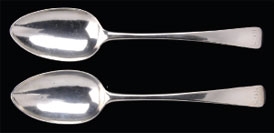

For more information on the sale, see:
February 2016 Fine Art, Antiques & Asian Auction
(http://jamesdjulia.com/catalog/?division=595)

NOTES FROM E-SYLUM READERS: OCTOBER 18, 2015
More on A. J. Fink
Dave Hirt writes:
Thanks for publishing the bio of Alvin Fink. I really do not know too much about him, but anything that I ever read about him was negative. Most collectors had a low opinion of him. I don't think he got too much repeat business. He finally tried to join the American Numismatic Association in 1948, but then his name was not listed in December 1948 membership directory; it looks suspiciously like objections were raised against his membership. I wish that I could state were I read about him, but it escapes my memory.
To read the earlier E-Sylum article, see:
ALVIN JOHN FINK (1875-1965) (www.coinbooks.org/esylum_v18n41a17.html)
Mark Salton's “Glossary”
In his article on numismatic glossaries last week, Dick Johnson wrote:
"Most compilers of glossaries rely heavily on Frey (Albert Romer). His 1917 Dictionary of Numismatic Names contains 4,111 entries with heavy emphasis on coin names and denominations, When Spink reprinted this in 1973 they added a section of 560 coin terms in five languages by Mark Salton."
George Kolbe writes:
Not quite so. Mark Salton's “Glossary” was first included in the 1947 Barnes & Noble edition.
To read the earlier E-Sylum article, see:
DICK JOHNSON GRADES NUMISMATIC GLOSSARIES
(www.coinbooks.org/esylum_v18n41a06.html)
Peacock or Turkey?
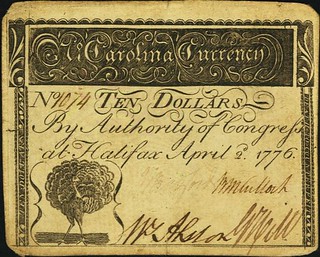 Don Cleveland writes:
Don Cleveland writes:
Regarding the allusion to and illustration of Lot 18947: North Carolina April 2, 1776 $10 Peacock from the Newman collection, given the date, place and circumstances surrounding the issue of this banknote, I suspect the "Peacock" is actually a "Turkey." Even crudely drawn, it looks more like a turkey than a peacock.
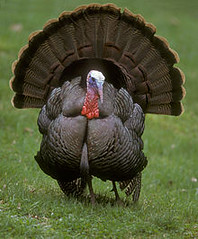


Maureen Levine writes:
After comparing the body shapes, we still think it’s a peacock. It is an interesting discussion, and other readers may have a different opinion.
To read the earlier E-Sylum article, see:
SELECTIONS FROM ERIC P. NEWMAN COLLECTION PART VII
(www.coinbooks.org/esylum_v18n41a20.html)
Jefferson Davis - His Marque
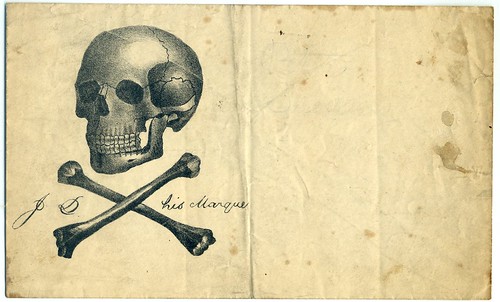
Heather Schena writes:
I bought this at a local coin show and am having a hard time finding out much of anything about it. I know it refers to Jefferson Davis and his issuance of letters of marque to Confederate privateers since there are other well documented envelopes from the Civil War era which use the same phrase, but with different images. I am unable to date this cover to the same period – no catalog I’ve found describes this specific design. I’ve read that it is far too large (5.25” x 8.5”) to be from that time and might date to the 1890’s. Davis died in 1889 – maybe this image was used at that time to mock him? If anyone has any insight on the history and purpose of this piece I am interested in hearing it.
More on the Yoachum Dollar
Regarding the Yocum/Yoachum Dollar, Bob Leonard writes:
I addressed this subject (definitively, I believe) in my article "The Legend of the Yoachum Dollar," Numismatist, March 1994 (received the Wayte and Olga Raymond Memorial Award and a Third Place Heath Literary Award). I certainly concur that the legend has improved with the retelling and that the account published recently is nonsense.
But apparently two members of the Yoachum family did mint their own "silver dollars"--perhaps of base silver, as one account says--from circa 1835-40 through 1845 or 1848. Since early accounts describe them as just like current silver dollars, they must have been copies of Mexican Cap and Rays pesos, the current silver dollar of the period. I proposed Riddell 254, a cast counterfeit dated 1836, as a possible candidate for the Yoachum dollar.
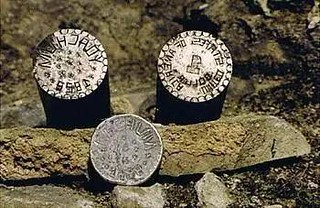 Incidentally, the fake dies shown in the article appear to have sunk using a screwdriver!
Incidentally, the fake dies shown in the article appear to have sunk using a screwdriver!
To read the earlier E-Sylum articles, see:
THE LEGEND OF THE ELUSIVE YOCUM SILVER DOLLAR
(www.coinbooks.org/esylum_v18n39a14.html)
QUERY: YOACHUM SILVER DOLLAR: APRIL FOOL?
(www.coinbooks.org/esylum_v11n15a21.html)
COMMENTS ON THE YOACHUM DOLLAR (www.coinbooks.org/esylum_v11n16a12.html)
MORE ON THE YOACHUM DOLLAR MYSTERY
(www.coinbooks.org/esylum_v12n39a19.html)
The Obvious Plant
Regarding the item about the prankster distributing fake books and signs, Dave Wnuck writes:
You owe me.
You owe me two hours of my life, as I went to the Obvious Plant website at your suggestion and read every single one of his signs, etc.
Great stuff!
To read the earlier E-Sylum article, see:
PRANKSTER DISTRIBUTES FAKE BOOKS AND SIGNS
(www.coinbooks.org/esylum_v18n41a31.html)
A Thank-You For Bill Groom
Jeff Starck writes:
I’d like to thank Bill Groom for his additional research into the Jesse L. Berch counterstamped coin. He provides fascinating insight Berch’s life and a possible explanation for the existence of this piece. Fun stuff, numismatics is!
To read the earlier E-Sylum article, see:
THOUGHTS ON THE J.L. BERCH COUNTERSTAMP
(www.coinbooks.org/esylum_v18n41a10.html)
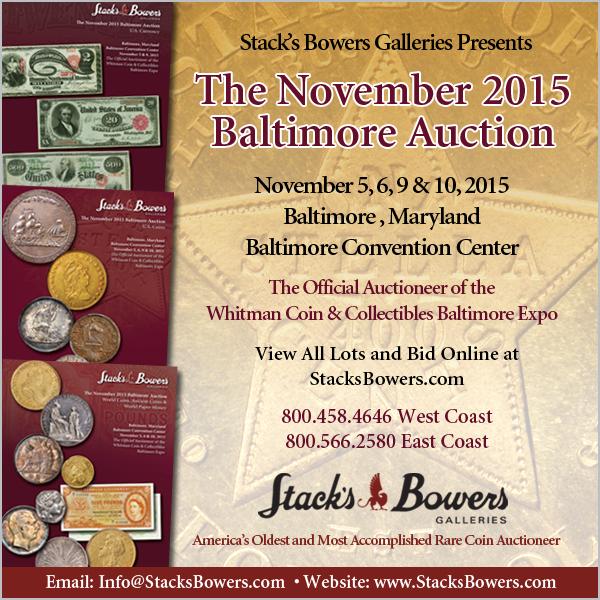
LATEST IN THE 1933 $20 GOLD CASE
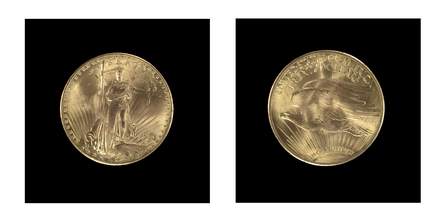
A federal appeals court is again weighing the fate of 10 rare gold coins possibly worth $80 million or more that the government says were illegally taken from a Philadelphia mint and wound up in a jeweler's hands.
A lawyer for jeweler Israel Switt's heirs told the 3rd U.S. Circuit Court of Appeals on Wednesday that authorities gave up any right to the coins when they failed to respond to the family's seized-property claim within 90 days.
The Treasury Department insists the $20 Double Eagles were stolen from the U.S. Mint in Philadelphia before the 1933 series was melted down when the country went off the gold standard.
They argued the heirs, Joan Langbord and her sons, cannot lawfully own the coins, which she said she found in a family bank deposit box in 2003. The government regained possession of the coins when the family brought them to the Secret Service to be authenticated.
So far in the decade-long battle, both sides have been declared winners.
In 2009, a judge ruled that the government improperly seized the coins and denied the family due process when officials at the U.S. Mint in Philadelphia decided to keep them after the family asked that they be authenticated. Two years later, a jury found the seizure had been legal because the coins hadn't been circulated and must therefore have been stolen.
A three-judge appellate court flipped the result again in April, ruling 2-1 in favor of Switt's family.
One Double Eagle, once owned by King Farouk of Egypt, sold in 2002 for $7.6 million, then a record for a coin. Its later owner, a London coin dealer once jailed by the U.S. over it, split the proceeds with the U.S. Langbord lawyer Barry Berke brokered that deal.
The Langbords offered the government a similar split but were rebuffed.
To read the complete article, see:
Court
again considers fate of seized gold coins worth $80M
(www.tuscaloosanews.com/article/20151014/NEWS/151019799/1350?Title=Court-again-considers-fate-of-seized-gold-coins-worth-80M-)
1933 $20 GOLD CASE: ENOUGH ALREADY
The latest round has begun in the legal drama deciding the fate of the 10 1933 $20 gold pieces in the possession of the family of the late Israel Switt, a Philadelphia jeweler who obtained them in the 1930s.
A federal appeals court is being asked to reverse its April decision that ordered the government to return the coins to the family, which has not had possession of them since 2005.
They had sent the rare coins to the Mint to be authenticated, and the government kept them, saying they had been stolen as none of them had been legally issued before President Franklin D. Roosevelt issued his gold recall order in March 1933.
Will the decision be different this time?
It might be.
Should we bet on a different outcome?
Probably not.
If this were a courtroom drama TV show there would be clever argument followed by the triumphant return of the coins to the family – all wrapped up in the course of an hour, or a two-hour special at most.
We collectors have been waiting for this to play out for 10 years right along with the family.
My hair has gone gray.
This has nothing to do with the trial and everything to do with the passing of a decade’s worth of time at my stage of life.
How much further this legal battle can be drawn out, I will leave it to the legal scholars to determine.
There is still the Supreme Court.
That would allow even more years to pass.
Legal drama, this may be, but popular entertainment it ain’t.
To read the complete article, see:
Gold drama moves slowly
(numismaticnews.net/buzz/gold-drama-moves-slowly?et_mid=791598&rid=238176646)

PETER MCTAGGART (1732-1825+)
Peter McTaggart (1732-post 1825) was born in Galloway, Wigtownshire, Scotland. He married Martha (1734-) in Scotland in 1752, and had a son James McTaggart (1754-1843). They immigrated to the British North American colonies sometime after the birth of their son James, but before 1761. By 1761 they settled at Boston, Massachusetts, where he worked as a merchant.

Boston Gazette and Country Journal, Monday, June 22, 1761.
In June 1761 we find him advertising in the Boston Gazette and Country Journal, the sale of “Sundry Medals of his present most Sacred Majesty GEORGE III, struck on a fine white Metal. One side contains, an exact portrait of His Majesty : The other Side a Heart encircled with Oak and Laurel Branches : the Motto, ENTIRELY BRITISH.”
Note his address is given as New-Boston, which was the "West-end of town". Three months earlier, from March 17-20, 1760, the "Great Fire" at Boston's "West-end" called "New-Boston" began at a joiner's shop and spread due to strong winds, which eventually destroyed 349 buildings. Despite the difficulties many suffered at "New-Boston" the medal honoring the anticipated new King was something so desirable that McTaggart highlighted its sale so that all of his other goods and wares were relegated to a footnote in his advertisement "Also, sundry other Articles."
One wonders if these "other Articles" were also exclusively numismatic. The odds of that are unlikely considering the historical milieu and were most probably an assortment of household goods, foodstuffs, or various materials, fabrics, metal goods, and so forth. The political gist of the advertisement shows strong support for the Royal Crown as did the governor Thomas Pownall, who resigned just 19 days before this advertisement was published.

Illustration in The Numismatist, Vol. XVI, No. 9, September (1903) : 262. This is the accession medal bearing the inscription proclaiming George III king. This is a later design from that described by McTaggart since it proclaims George III as king October 26, 1760, four months after his advertisement.
These were pre-accession to the Royal Throne medals struck, and most probably continued to be dispersed early in his reign prior to his marriage and coronation in September. The illustration below taken from The Numismatist is the accession medal based on a similar design described by McTaggart in his advertisement with the exception of the plinth block and its inscription, which, of course, relates to events four months in the future. Consequently, the accession to the throne medal (if we can properly call it that) prior to coronation must have been anticipatory of George II's demise, which eventually came October 25th of that year.
Apparently this medal was to spread the propaganda that the grandson of George II, though not an Englishman, is "Entirely British," namely in education, culture, affections and sentiment. The phrase "Entirely British," mimics that of the March 8, 1702 Accession Medal Queen Anne (1665-1714) "Entirely English" designed by John Croker and its copy made by Christian Wermuth.
The engraver at the British Mint of Italian descent, Thomas Pingo (1714-1776), designed the Accession Medals in silver and bronze. The heart within a wreath of laurel and oak rests on a plinth block bearing the 4-line inscription BORN MAY 24/1738/PROCLAIMED/OCTR. 26 1760. Is the medal described by McTaggart also by Thomas Pingo? Is this a mere propaganda medal clearing the path of contention and opposition to the soon to be new king?
George III (1738-1820), ascended the throne of England on October 22, 1760 and crowned September 22, 1761, two weeks after his wedding to Charlotte Sophia of Mecklenburg-Strelitz.
In 1790, according to the U. S. Census McTaggart moved to York Township, York County, Pennsylvania. He appears to have left the United States before 1800. He is listed in the 1825 Census of Quebec, Quebec, Canada together with his son James and a daughter. He died in Sophiasburgh Township, Prince Edward County, Ontario, Canada.
To read the complete article, see:
McTAGGART,
PETER (https://sites.google.com/site/numismaticmallcom/encyclopedic-dictionary-of-numismatic-biographies/mctaggart-peter)
ANS LIBRARIAN, A.H. COOPER-PRICHARD
It is such a great honor to be the Librarian of the American Numismatic Society, and there is a special kinship I feel with those who have come before me, an exclusive club of dedicated stewards who have assembled and cared for this astonishing collection for over a century and a half. Alas, the list of such individuals I can commiserate with in person is quite short, as there have been only two librarians preceding me in the last forty years: Frank Campbell, whose retirement in 2008 capped a career that spanned a third of the ANS’s entire 150-year existence, and my immediate predecessor, Elizabeth Hahn Benge, who thankfully remains just an email away, ready to dispense advice when I most need it.
I’m also, naturally, curious about those who came before us. Happily, not only do opportunities to explore such topics arise in the course of my regular day-to-day business, but I have the great fortune to be surrounded by a unique set of historical records into which I can dive to find the answers to my questions, though such exploration usually just uncovers more areas to investigate. Recently, I found myself looking at the lives of several of the ANS librarians who were active at about the turn of the nineteenth- into the twentieth-century. It was an era of big changes at the Society, as it moved into its new building at Audubon Terrace and brought in paid professional staff to handle operations previously carried out by member volunteers.
The catalyst for much of this historical probing was a curious figure I have been intrigued by for a while, A.H. (Arthur Henry) Cooper-Prichard, the Society’s first professional (or paid) librarian (1911-1912). Born in Kingston, Jamaica, in 1874 and educated in England, Cooper-Prichard’s work as a numismatist is well documented. In fact, he recounts most of it himself in a long and somewhat rambling letter of application for “an official position” sent to ANS president Archer Huntington in 1907 (with which he included a handbill from a school play in which he appeared in the role of a “happy husband”). Without a care for our modern notions of succinctness when it comes to application letters, his goes on for six pages, skipping from one topic to the next. He tells of getting his start in numismatics at the age of nine in the British Museum and subsequently building a collection of about 200 pieces (Greek and Roman mostly, along with some English and French regal coins), eventually securing positions as a cataloger for the Museum of Fine Arts in Boston, the Provincial Museum of Nova Scotia, and the Brooklyn Institute of Arts and Sciences.
He claims to have written “two voluminous works” that were nearly ready for publication, one on the coinage of England and another on primitive money, which, he says, “by the cruelest stroke of fate, burned in my trunk en route for Canada,” the flames also consuming his numismatic library and coin scales. Though discouraged and despondent, he found his interest in such work refreshed through time spent cataloging the extensive coin collection of Warren Demman Gookin (fig. 2). He had talked Gookin’s nephew out of donating the collection to the Brooklyn Museum, where, he said, “the importance of coin collections and numismatic work was inadequately provided for” (the reason, he added, he could no longer continue to work there), and so instead over two thousand of his Greek and Roman coins were given to the ANS.
Cooper-Prichard’s letter to Huntington came on the heels of this donation and he no doubt assumed it would be seen as a feather in his cap by the president. Fully aware of Huntington’s collecting interests, he also let it slip casually that “oddly enough, I have always taken a more than usual interest in all things pertaining to Spain and South America and the West Indies.” His letter is followed by copies in his own hand of eight glowing testimonials from his former employers and schools. It was all to no avail, at least at that time. He was told that “at the present time all official positions are filled” but that his application would be considered in the future. Four years later he was hired as librarian.
With his letter of application, Cooper-Prichard included a small advertisement for his services identifying “foreign and ancient coins” and cataloging using a “new and minute method.” This was his own invention whereby coins of any kind from any period could “be classified upon a single page,” an approach he says was adopted at the Boston Museum—or at least “an imperfect development of it.” He boasted to Huntington that “no other system even approaches this for its useful facilities.” (It is worth noting, however, that he felt it unnecessary to apply this method to his catalog of the Gookin collection). Cooper-Prichard was quite proud of his system and published a description of it in the Society’s American Journal of Numismatics. Not everyone was so enthusiastic. That year, the Society’s council members were looking at ways to improve the journal. One of the suggestions was blunt: “articles such as appear on page 157 of the present issue should be eliminated.” This was Cooper-Prichard’s “Proposed Arrangement of a Catalogue of Coins.” In 2006, a researcher looking into Cooper-Prichard’s life called this “one of the most entertainingly pompous pieces of writing I have seen in a long time,” citing in particular this quotation:
To omit a single detail of known information, regarding a coin or medal, whether on the specimen itself or outside, is unpardonable. Almost equally unpardonable is it to place one word too much in such a description. That the greatest numismatic writers have sinned in both these ways is nothing in favor of such carelessness any more than bad jokes are excusable because Shakespeare, to please the inferior sort amongst his audience, disfigured his writings with them.”
It is not clear why or under what circumstances Cooper-Prichard’s tenure as librarian came to an end at the beginning of 1912. He refers at one point to “the termination of my service” at the ANS but seemed to bear no ill-will toward it, telling secretary Bauman Belden he planned to come visit him and do some research but the writing of what was apparently a non-numismatic book was taking up much of his time. He referred also to promises he had made (“while I had every reason to believe myself still an officer of your Society”) of having books sent to the British and Fitzwilliam museums and said he hoped the ANS would follow through in his absence. By the end of the year he was in England seeking a position with the government there, and by 1915, three years behind in his dues, he was dropped from the Society’s rolls. From that point on he seems to have disappeared from the historical record as a numismatist
To read the earlier E-Sylum article, see:
WILLIAM WEEKS AND HIS 1839 LARGE CENTS
(www.coinbooks.org/esylum_v18n34a16.html)
MORE ON WILLIAM WEEKS (www.coinbooks.org/esylum_v18n35a12.html)
MORE ON WILLIAM WEEKS (www.coinbooks.org/esylum_v18n36a16.html)
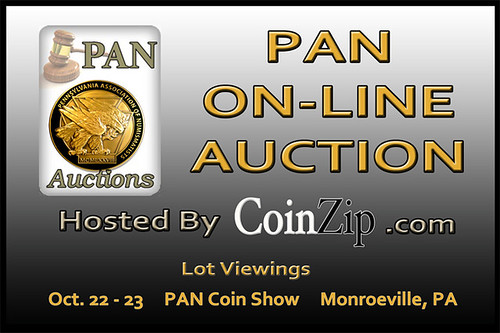
THE U.S. DIPLOMATIC MEDAL
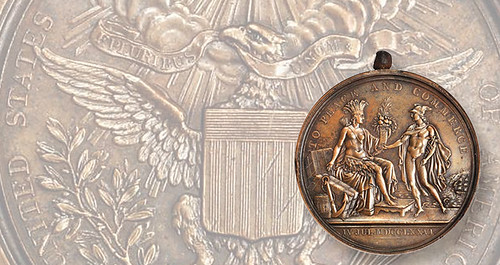
Originally conceived by Thomas Jefferson and personally approved by George Washington, the Diplomatic Medal was intended to be struck in gold and used as the official gift of the United States to recognize foreign diplomats for their service. Such gifts were customary at the time: John Adams received a large gold medal from the Netherlands in 1788 to recognize his service as minister plenipotentiary, a medal that survives in the collections of the Massachusetts Historical Society.
When Jefferson returned from Paris in 1789 and was elevated to the position of secretary of state, he left his post in the hands of William Short, his longtime deputy. Soon thereafter, with gifts he had received from the French still fresh in his mind, Jefferson hatched his idea for a substantial gold medal, to be hung on a large gold chain whose length depended upon the diplomat’s term of service. The gold chain would be tantamount to a cash gift, but the medal could be retained as a keepsake.
Corresponding with Short in Paris, Jefferson asked that the medal be executed by Augustin Dupré, who had earlier gained fame among the Americans for his work on the Libertas Americana medal and several of the medals voted by Congress to recognize military success during the American Revolution.
Though records show two gold medals were struck, neither has survived. Both medals were given to French aristocrats who served as ambassadors to America, and scholars today assume they were destroyed during the French Revolution. The surviving paper trail also indicates that six bronze medals were struck. Four of those are known today: one in Princeton University, three more in private collections. The finest of them, and the only one to retain its original loop, was recently sold in an October 1 Stack’s Bowers Galleries auction for $188,000.
To read the complete article, see:
A rare bronze medal of
early America: Colonial America (www.coinworld.com/news/us-coins/2015/10/rare-diplomatic-medal-in-bronze-sells-at-auction.html#)
U.S. DIPLOMATIC MEDAL RESEARCH MATERIALS
Here are the documentary references I have on the Diplomatic Medal. I believe most of this knowledge has been lost to time and that it should be once more part of our contemporary understanding about the Medal.
I found this information approximately two months ago while in the process of building my numismatic library. It was prior to having any knowledge that an original Diplomatic medal would be available for auction. I was quite excited to have it since I believed this provided me with more information than what most collectors had at this time. I confirmed this by asking the definitive expert on medals, John Kraljevich, cataloguer for the Stack’s Pogue and Rarities Night auctions, about what was the earliest auction reference that he recalled. We had only become acquainted with one another a week earlier. He responded that it was in the early 1880s in the U.S. and possibly the mid 1870s in England.
 My search began when I found Lot 2691 in the Bangs, Merwin & Co. auction catalogue of October 1863 for W. Elliot Woodward, referencing a
medal, “To Peace and Commerce,” “Jul. MDXXVI.” It took me a moment to realize that it was about the Diplomatic Medal since that title was not used.
The medal sold for $100, a very sizeable sum back then, and also referenced another recent transaction of it for $100 as well. Using the amount I
paid for the medal, this would work out to an approximate 5% compound annual growth rate, which appears to be low for items of such great rarity.
Subsequently, I received the Bushnell auction catalogue where a Diplomatic Medal was sold for $50, Lot 313, and referenced this catalogue in the
final sentence. Apparently this sentence has been overlooked, otherwise this auction would have been cited in your article about the medal I
responded to.
My search began when I found Lot 2691 in the Bangs, Merwin & Co. auction catalogue of October 1863 for W. Elliot Woodward, referencing a
medal, “To Peace and Commerce,” “Jul. MDXXVI.” It took me a moment to realize that it was about the Diplomatic Medal since that title was not used.
The medal sold for $100, a very sizeable sum back then, and also referenced another recent transaction of it for $100 as well. Using the amount I
paid for the medal, this would work out to an approximate 5% compound annual growth rate, which appears to be low for items of such great rarity.
Subsequently, I received the Bushnell auction catalogue where a Diplomatic Medal was sold for $50, Lot 313, and referenced this catalogue in the
final sentence. Apparently this sentence has been overlooked, otherwise this auction would have been cited in your article about the medal I
responded to.
The American Journal of Numismatics January 1875, volume IX, number 4, pages 78-80, had a wonderful discussion about the medal and its history. What was especially interesting is that H.R. Linderman, Director of the Mint, stated that, “I was not aware that such a Medal had ever been struck.” The time period referenced was 1867. This was in response to a letter from Professor Jules Marcou, who owned a led proof of the Medal which he acquired from Dupre’s son. It was at this time that I also learned another name for this Medal, the Medal commemorative of American Independence.
It was in AJN April 1875, volume IX, number 3, page 65, where I was really shocked. The final paragraph references a Mr. J. Francis Fisher, of Philadelphia, who communicated a description of the Medal to the Massachusetts Historical Society in 1837. This moved a cited reference about the Medal to nearly 50 years earlier than anything I had read up to this point. On page 66, extracts of letters between Thomas Jefferson to William Short were also cited.
In the AJN October 1882, volume XVII, number 2, page 30, it states, that the Medal was in the possession of Mr. Fisher, who died in 1872, but a search of his effects failed to discover it. I thought this only added to the mystery and charm of the Medal. Did he in fact own one and thus, 1837 would be the earliest date of ownership for any Diplomatic Medal or had he only seen one and this explains why he only communicated a description to the MHS. We will probably never know.
I have included the AJN October 1882, volume XVII, number 2, pages 27-31, since it has an interesting discussion about a Centennial Anniversary of the Great Seal of the United States medal being struck. It explains that the led proofs of Professor Jules Marcou were used to reproduce perfect facsimiles of the original dies in 1876 . In the final paragraph, p. 31, it states that the original medal sold in the Bushnell auction should have been secured for the Mint Cabinet.
Finally, in AJN January 1883, volume XVII, number 3, page 70, in what may be the oldest transaction cited so far, “In the collection of D.B. Warden’s Books, Maps, Engravings and Medals, relating to America, sold at Paris, in 1840, was the following Medal….” It references the Diplomatic Medal.
I hope these references and “new” information help with our understanding of the importance of this medal. I could not be more ecstatic to be the latest curator of such a national treasure. To be able hold a part of our history where Thomas Jefferson and George Washington were so intimately involved with its creation is awe inspiring to me.
By way of background, I returned to the hobby 18 months ago after an absence of 53 years when I left it at age twelve. It makes me feel like I am a kid again.
THE BOOK BAZARRE
ORIGINAL BANDED FRACTIONAL PACKS
In my early days as a fractional collector (in the late 1980s), I was making my way down the aisles at a coin show. At one table, a dealer had broken open a pack of FR1309 5th 25¢ Walker notes. In his case was (40) gem Walkers, looking shiny and new, fanned out for maximum appeal. The dealer said to me,”take your pick of any Walker in my case, and I’ll let you have it for $40 (give or take).”
I went through the notes; picked out the best one, and thought to myself I did well. I noticed the band, discarded at the side of his case, and had to ask, “Why did you break open the pack?” He told me that there was more money to be made selling them individually than as a pack of 40. My initial reaction was sympathetic to his perspective, but, in the process of squeezing out a few more dollars, a part of fractional history was lost forever. As a single piece of currency, the Walker is just a common fractional note. But, as a banded pack, it becomes a romantic piece of history; a survivor from a bygone era. Those (40) Walkers were a band of brothers bound through the decades by an ornate “TEN DOLLARS” band with a proud and elegant design.

A pack of fractionals assembled and banded in the 1870’s represents how bank commerce was transacted; no doubt it was in a teller’s drawer. Perhaps it was withdrawn by a merchant to make change at his local business. Like rolls of nickels, dimes and quarters today, the merchant left the bank that day with several packs. Whatever circumstances arose, that one single pack of Walkers was never opened; stashed away for posterity. Fast forward to that fateful day, over 100 years later, when this dealer destroyed a part of fractional lore for a few more dollars. In no uncertain terms, this was shameful act of self-interest. Banded packs (as well as sheets) have risen considerably in value as the available supply diminishes. The sum is now worth more than the parts. While this is self-correcting, one cannot help and think of that pack lost forever in the 1980s.
Banded packs have become quite rare, and there are only a few varieties available today. Part of the appeal is the actual bands. From the Tom O’Mara sale in 2005, the following Heritage lot description gives us great insight on how fractionals were bundled. The lot description reads as follows:
Lot 15679 - An Incredible Collection of Fractional Currency Treasury Bands. Tom has acquired a group of ten different bands, several of which we have never seen before, including three larger bands apparently intended to hold multiple bundles. The largest was intended for $50 in 10¢ notes. We've seen individual ordinary bands sell in the $25 range and suspect that this irreplaceable group of ten should be worth at least...(sold for $488.75).
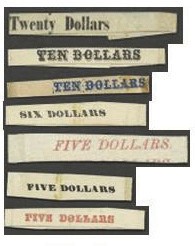
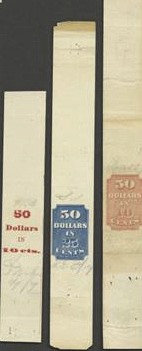
The bands give us a more textured reminder of the past than a single note. The ‘SIX DOLLARS’ band is especially intriguing… perhaps it was a band from a pack of (200) third issue 3¢ fractionals.
THE INTERNATIONAL NUMISMATIC CONGRESS
The 15th International Numismatic Congress was just held in Taormina, Sicily, Italy from September 21-25, 2015. There were 750 participants and 400 papers were delivered, plus another 50 papers in the form of posters (these numbers are approximate). It is one of the oldest international scholarly conferences in the field of history. The International Numismatic Congresses, with their dates and locations, are:
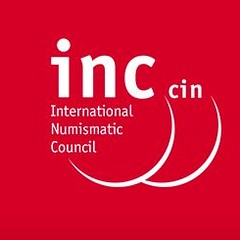 1. Brussels, July 5-8, 1891
1. Brussels, July 5-8, 1891
2. Paris, June 14-16, 1900
3. Brussels, June 25-29, 1910 (this was also an international medals exhibition)
4. London, June 30-July 3, 1936
5. Paris, July 6-11, 1953
6. Rome, September 11-16, 1961
7. Copenhagen, August 28-September 2, 1967
8. New York and Washington, September 10-16, 1973
9. Berne, September 10-15, 1979
10. London, September 8-12, 1986
11. Brussels, September 8-12, 1991
13. Madrid, September 15-19, 2003
14. Glasgow, August 31-September 4, 2009
15. Taormina, September 21-24, 2015
16. Warsaw, September 20-24, 2021
As can be seen from the above list, international co-operation in the field of numismatics, which got off to such a fine start in 1891, fell dormant during the dark years of 1914-45, with only the London 1936 Congress keeping it alive. After the Second World War, however, there was a new era of co-operation, and the Congresses have been held every six years or so.
The International Numismatic Congress is organized by the International Numismatic Council, and the hard work of the actual preparations is done by the local coin cabinet or university (at Taormina, it was the University of Messina). The International Numismatic Council and International Numismatic Congress are responsible for four important publications. One is the proceedings of each Congress. These contain some of the papers delivered at the Congress (many participants choose to publish elsewhere).
The proceedings present a real olla podrida of numismatics – you never quite know what gems you will find. Since the Copenhagen Congress in 1967 the Congress has been the occasion for the publication of the Survey of Numismatic Research. The International Numismatic Council publishes an annual Compte Rendu. There are several important series of articles published in the Compte Rendu. One series, “Les Grands Numismates,” publishes biographies of prominent numismatists. Another series concerns the laws concerning coin finds. The INC also publishes the International Numismatic e-Newsletter (INeN) with notices of upcoming conferences, exhibitions, and all sorts of other things – for example, there is a wonderful hoard of gold ducats and florins that was published in INeN 19.
The official languages of the International Numismatic Council are English, French, German, Italian, and Spanish, so you have to be a bit of a linguist to get full advantage from its publications. Here is a link to the proceedings of the Brussels 1891 Congress:
Here is a link to the proceedings of the Paris 1900 Congress:
Here is a link to the website of the International Numismatic Congress in Taormina:
This link leads directly to a page of the International Numismatic Congress in Taormina that has the abstracts of the papers, to give an idea of the topics that were discussed:
http://www.xvcin.unime.it/programme/scientific-programme/
Here is a link to the website for the 16th Congress, which will be held in Warsaw in 2021; they have a short film (7 minutes in the English version), “2300 Years of Coinage in Poland,” highlighting what we can look forward to in 2021:
http://en.uw.edu.pl/the-xvi-international-numismatic-congress/
Here is a link to the website of the International Numismatic Council – further links will lead to the International Numismatic e-Newsletter (INeN), and to various articles published in the Compte Rendu, such as the series “Les Grands Numismates” and “The Laws Concerning Coin Finds.”

WAYNE'S NUMISMATIC DIARY: OCTOBER 18, 2015
Back to the Future
 Tuesday, October 13, 2015 was an enjoyable day for me. At noon I participated in a conference call for those of us working on the Newman
Numismatic Portal. Progress was being made on many fronts; a new software release would soon be in place for internal testing, Frey's
Numismatic Dictionary was being prepared for online use, Pete Smith's American Numismatic Biographies were already in place
and Martin Gengerke's American Numismatic Auctions data was starting to be loaded. And of course, the digitization of numismatic
material continued apace. Plans were afoot to increase scanning capacity, and the team was already digitizing content at the rate of about
20,000 pages a month from the Eric P. Newman Library and elsewhere. And Len Augsburger had just hand-delivered another box of new material
on loan from Dan Hamelberg.
Tuesday, October 13, 2015 was an enjoyable day for me. At noon I participated in a conference call for those of us working on the Newman
Numismatic Portal. Progress was being made on many fronts; a new software release would soon be in place for internal testing, Frey's
Numismatic Dictionary was being prepared for online use, Pete Smith's American Numismatic Biographies were already in place
and Martin Gengerke's American Numismatic Auctions data was starting to be loaded. And of course, the digitization of numismatic
material continued apace. Plans were afoot to increase scanning capacity, and the team was already digitizing content at the rate of about
20,000 pages a month from the Eric P. Newman Library and elsewhere. And Len Augsburger had just hand-delivered another box of new material
on loan from Dan Hamelberg.
Before leaving the office that afternoon I got an email from Len with the subject line "Chapmans online". Dan's Chapman catalogs were beginning to show up online as Internet Archive processed the images for us. I clicked the link and was soon paging through the May 10, 1893 sale of the Nicholas Petry collection.
Just then I heard a voice in my head say, "Welcome to the year 2015, Marty McFly - here's your hoverboard."
For those too young to get the reference, Marty McFly was the Michael J. Fox character in the 1980's time-travel movie Back to the Future. At the end of the film, to set up the sequel, he would travel 30 years into the future, landing about 4:30 P.M. on October 21, 2015, into a world of hoverboards, flying cars and self-tying shoes.
Well, we're still waiting for flying cars, but self-driving ones are already on the roads, and Moore's Law is still relevant. Perhaps only geeks know or care about the formula Intel co-founder Gordon Moore postulated 50 years ago- that the processing power of computers would double roughly every two years. What that means for the rest of us is that computers have gotten steadily smaller and smaller and cheaper and cheaper at an astounding cumulative rate. Computing power than once cost millions now sits in the hands of sixth-graders in the form of cell phones. And computer storage has become so cheap it's virtually free, allowing for the nearly unlimited storage of digital files.
Which brings us back to numismatics. 30 years ago it was just a pipe dream that in the future we would be able to store, search and read a vast digital numismatic library. The Newman Numismatic Portal is making that dream a reality. NNP is your hoverboard, numismatic researchers. Welcome to the future.
Nummis Nova: Gadsby's Tavern
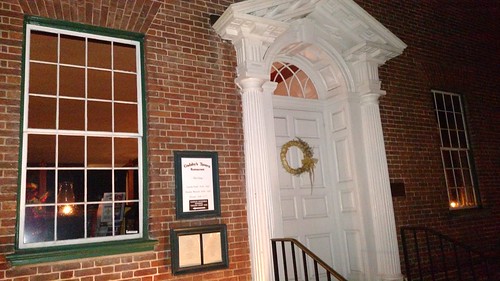
Later that evening I guided my dumb old non-self-driving car down King's Highway toward Old Town Alexandria, VA for the October meeting of my northern Virginia numismatic social group, Nummis Nova. We were doing some time traveling of our own, stepping into the past at Gadsby's Tavern. Consisting of two buildings (a circa 1785 tavern and the 1792 City Hotel), the establishment at 138 N. Royal Street hosted meetings and social events; among its guests were George Washington, Thomas Jefferson, John Adams, James Madison & James Monroe. Washington frequently visited the taverns, and twice attended the annual Birthnight Ball held there in his honor.
I ran into Joe Levine and Jon Radel on the sidewalk outside, and we entered together. A large party was already seated in the larger front dining room. The hostess, dressed in period garb, asked us to follow her for a more roundabout route to our room. Soon we were cutting though the kitchen of the compact restaurant, like Colonial Goodfellas (there, I couldn't resist another old movie reference).
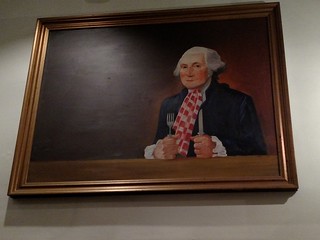 We found seats at a back table and were joined by Aaron Packard. Our hosts for the evening were Ron Abler and Joe Esposito. I was delighted
to find the restaurant had prepared custom printed menus for the evening with "NUMMIS NOVA Dinner" and the date at the top. I ordered the
Chicken Cordon Bleu and a glass of tasty rum punch.
We found seats at a back table and were joined by Aaron Packard. Our hosts for the evening were Ron Abler and Joe Esposito. I was delighted
to find the restaurant had prepared custom printed menus for the evening with "NUMMIS NOVA Dinner" and the date at the top. I ordered the
Chicken Cordon Bleu and a glass of tasty rum punch.
We soon had a pretty packed house, filling all three tables in the room dominated by towering windows and a fireplace, all lit by candlelight. It was not a good environment for viewing coins, but luckily some of us had brought flashlights. Even the waitresses had little flashlights. So not everything was Colonial. When I needed a restroom I asked if there was an outhouse in the back. "Sure, honey", the waitress said, with a grin. "I'll show ya". Actually, the "Necessary Rooms" were downstairs, where you pass this painting of Washington licking his wooden chops before dinner.

The theme for the evening was numismatic books, and I carefully showed a few people some of my prized early American numismatic literature from the Armand Champa sales.
Joe Esposito brought a nice copy of Dye's Coin Encyclopedia and Joe Levine brought the massive Eidlitz book, Medals and Medallions Relating to Architects.
Here are a few photos of the evening. The center table held six of us. Cut out at the right was Tom Kays. Sorry!
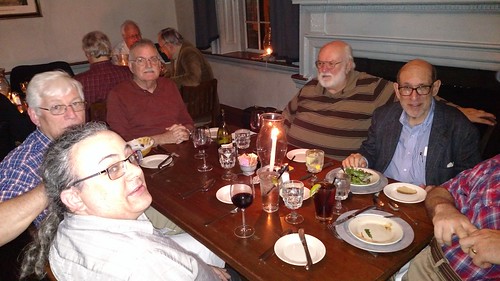
Eric Schena, Dave Schenkman, Howard Daniel
Gene Brandenburg, Joe Esposito
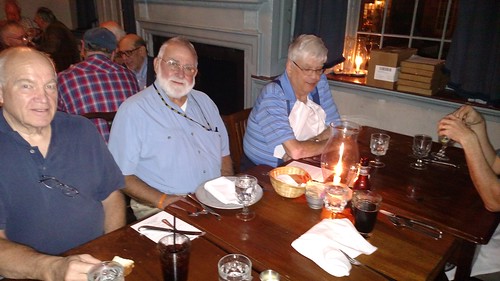
Mike Packard, Ron Abler and Julian Leidman
I later visited Ron's table whose other denizens were Wayne Herndon and former U.S. Mint Director Ed Moy, who was planning some overseas travel to research his upcoming Whitman books. I didn't get to speak with Ed for long, but I learned a lot about mustaches from Wayne. He grew up in Texas and after some experimentation decided on his signature mustachioed look. He's sported it for 27 years. Given his youthful appearance he must have started it when he was five. On the windowsill are boxed copies of Dave Schenkman's great new book on Virginia Tokens.

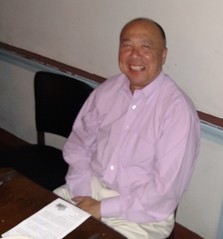
Wayne "The Mustache" Herndon and Ed Moy
Eric Schena brought a great rarity to the dinner. I love Clearing House Certificates, and was really glad to see this piece.
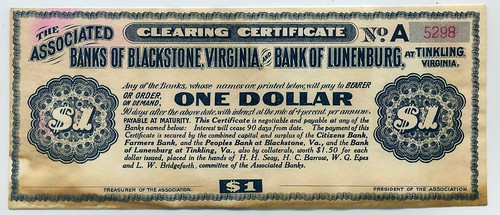
Eric writes:
One of the items I brought was a previous unknown Panic of 1907 scrip note that I picked up from Richard Jones at the recent Virginia Numismatic Association Convention at Fredericksburg. It is a remainder $1 note issued by the Associated Banks of Blackstone & Bank of Lunenburg at Tinkling, Virginia about which the Shafer/Sheehan reference on panic scrip notes: "An issue of this scrip is reported to have been issued by this bank. No details are known at present."
Tinkling is now part of Kenbridge in Lunenburg County in South Central part of the state. Everyone I have shown this to has never seen one nor does it appear that others have turned up to my knowledge, though there may be others out there. I think it's a pretty neat find and shows that even though it is fairly recent, discoveries can still be made.
Anyone who thinks 1907 is recent is my kind of collector. My kids think anything from last month is too old to bother with. A marvelous find, and rarer than hen's teeth. Congratulations! Dave Schenkman also brought some paper money, including two advertising notes featuring rebus puzzles. For fun, I'm presenting one of them in another article in this issue, challenging readers to figure it out.
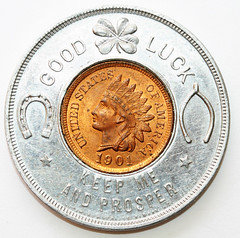
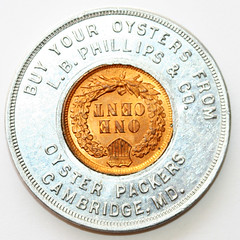
Dave also brought along this gorgeous encased cent from the L. B. Phillips & Co. Oyster Packers of Cambridge, MD. Neat!
Aaron Packard displayed some nice high-grade 19th century tokens. Steve Bishop's items included a whopping piece of 1731 Swedish Plate Money and some nice Art Deco medals.

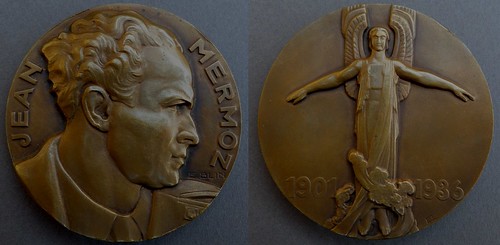
Jean Mermoz Medal by Blin
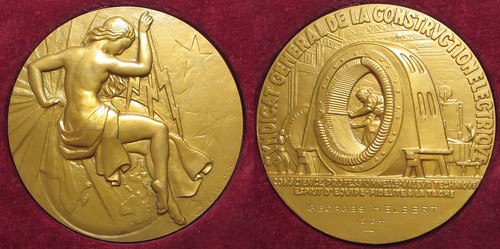
Medal Honoring Electrical Construction Workers
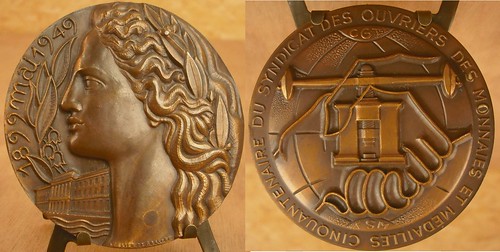
Medal Honoring Paris Mint Workers
The reverse, showing a screw press, was upside-down in the eBay seller's photo. Steve fixed it for us, although it looks a little weird hanging from its stand.
Appropriately for a venue frequented by Presidents, a couple of our members (Joe Levine and Aaron) exited early to watch the evening's televised Democratic Presidential debate.
It was another marvelous evening for numismatics, and a great dinner to boot. His Excellency would be proud.
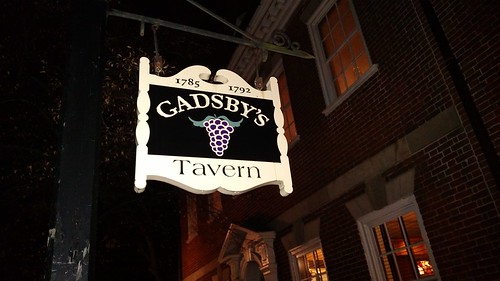
New Coins
My last report for this week involves some new coins, which I found in my change for the first time this week. Both have been discussed
earlier in The E-Sylum. First is the America the Beautiful Bombay Hook quarter designed by artist Joel Iskowitz and engraved by
Phebe Hemphill of the U.S. Mint. The design holds up well "in person" and looks great. I didn't note this in my earlier
articles, but the composition is similar to Iskowitz' earlier 2004 National Parks Quarter for the Florida Everglades. Nothing wrong
with that, though - I think both designs work well.
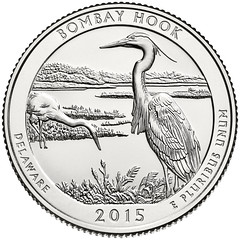

Bombay Hook and Everglades Quarters
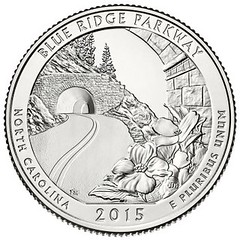 Next is the 2015 Blue Ridge Parkway quarter. I was less impressed seeing this one in person. When I first looked at it, I couldn't
figure out which end was up. I had to rotate it a couple times before I recognized the design, which comes off rather flat. Part of the problem is
the nature of the subject. A roadway just doesn’t lend itself well to being a central figure of a scene. About a quarter of the design shows a
portion of the roadway, but even with the center striping it looks more like an empty field than part of the central design.
Next is the 2015 Blue Ridge Parkway quarter. I was less impressed seeing this one in person. When I first looked at it, I couldn't
figure out which end was up. I had to rotate it a couple times before I recognized the design, which comes off rather flat. Part of the problem is
the nature of the subject. A roadway just doesn’t lend itself well to being a central figure of a scene. About a quarter of the design shows a
portion of the roadway, but even with the center striping it looks more like an empty field than part of the central design.
I had noted that "It's hard to pull off a complex design like this on a quarter-size coin", and we may have ended up with a dud. I would be curious to see this in the large silver size - it may come off better there.
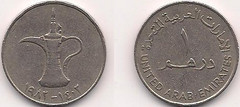 Lastly, I got a foreign coin in change at lunch Wednesday, and it was the first time in a long, long while that I'd encountered
anything but a U.S. or (sometimes) Canadian coin. It was an Arabic design; when I looked at it later I could see that it also had "United Arab
Emirates" in English. I located an image on the Currency Wiki - it's a 1 dirham coin. The image is labelled 1982, but mine is a different
date.
Lastly, I got a foreign coin in change at lunch Wednesday, and it was the first time in a long, long while that I'd encountered
anything but a U.S. or (sometimes) Canadian coin. It was an Arabic design; when I looked at it later I could see that it also had "United Arab
Emirates" in English. I located an image on the Currency Wiki - it's a 1 dirham coin. The image is labelled 1982, but mine is a different
date.
What unusual foreign coins have readers found in their change lately?
To read the complete article, see:
United Arab Emirates dirham
(http://currencies.wikia.com/wiki/United_Arab_Emirates_dirham)
To read the earlier E-Sylum articles, see:
EVERGLADES NATIONAL PARK QUARTER LAUNCH
(www.coinbooks.org/esylum_v17n51a14.html)
BOMBAY HOOK WILDLIFE REFUGE QUARTER LAUNCH
(www.coinbooks.org/esylum_v18n38a25.html)
ARTICLE PROFILES PARKWAY QUARTER DESIGNER FRANK MORRIS
(www.coinbooks.org/esylum_v18n26a19.html)
TRIBUTE TO CCAC MEMBER GARY MARKS
 On October 8, 2015, after the vote on the 2016 Lions Club Commemorative coin, I grabbed Gary Marks by the hand.
On October 8, 2015, after the vote on the 2016 Lions Club Commemorative coin, I grabbed Gary Marks by the hand.
I looked him in the eye and thanked him for his service on the Citizens Coinage Advisory Committee (CCAC) on behalf of all Americans who may never know about the paradigm shift that occurred during his Chairmanship.
I was expressing my personal sadness at losing regular contact with someone I have come to know as a friend over the last eight years. But I was also recognizing the passage of an era—the end of a dark period at the United States Mint and the start of a new, exciting and creative period. Gary Marks was the Chairman of the CCAC during that transition and without his stewardship, it might never have happened.
Events at the United States Mint hit their low point around 2010. Artistic decisions were being made by the Mint’s Design Review Committee, which consisted of people who had no formal or informal training in art. In fact, no one on the committee particularly liked art, visited art galleries or read much about coins or medals. The group was driven by the mints manufacturing schedule and marketing demands. The Design Review Committee was nothing more than a marketing and manufacturing committee.
There was a serious disconnect between statements that came from the Director of the Mint and the actions of the Mint staff. In some instances, it was just embarrassing. But more often, the conflicts contributed to an ever-worsening working relationship among people at the Mint. The low morale almost completely squelched creativity. If a good coin design happened to emerge during that period, it was likely an accident.
Since the Mint recommends the appointment of all but four members of the CCAC, there were few of us at the meetings who would object to the processes happening at the Mint. It took courage and a passion for art for people to be willing to speak out or be too critical of a particular set of designs or a Mint procedure. But eventually, Gary and others began to not only lend support to my criticisms, but also to take the lead.
By 2010, the CCAC was in full rebellion. Much of what happened behind the scenes was never made public, but the equivalent of a Declaration of Independence was written at the summer CCAC meeting held at the American Numismatic Association headquarters in Colorado Springs. That meeting resulted in the formation of a subcommittee to study the problems at the Mint and make recommendations for improvement. The Committee’s recommendations became known as the “Blueprint for Advancing Artistic Creativity and Excellence in United States Coins and Medals,” and were adopted as the recommendation of the full CCAC in early 2011.
The Blueprint was a game changer at the Mint. Rosie Rios, Treasurer of the United States, and Richard Peterson, Acting Mint Director worked tirelessly to change the status quo at the Mint and to implement the Blueprint. Staff changes were made and the dreaded Design Review Committee was disbanded. The artists were moved out of their small, windowless cubicles and into an atelier-style space with windows and light at the Philadelphia Mint. Design decisions moved away from the total control by sales and marketing. A new emphasis on the artists and the engravers emerged, and the role of the CCAC was expanded to provide input on design themes prior to the development of designs.
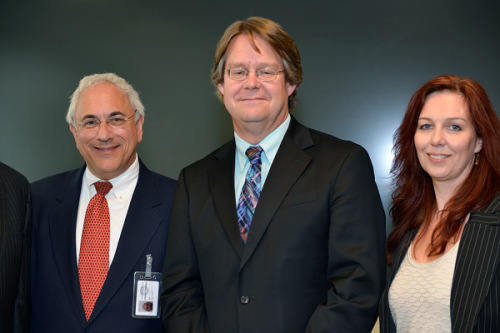
Blueprint Committee Members Donald Scarinci, Gary Marks, Heidi Wastweet
The most significant change, however, was in the relationship between the Mint and the CCAC. Contentiousness was replaced by cordiality. Instead of rushing through design approvals merely to fulfill a statutory obligation, the Mint began to view the CCAC both as a fountain of fresh ideas from a cross section of America and as a focus group for the broader community of Americans who care about the design of the coins they carry. Perhaps for the first time since the legislation was drafted, the CCAC now performs the role that Congress intended it to perform.
The role that Gary Marks played in all of this was a giant one. From the events leading up to the Blueprint to its implementation, and right up to his final day on the CCAC last week, he took every opportunity to reminded everyone that, “it’s all about the art.” Gary Marks will long be remembered for the changes he helped make for this to become a reality at the United States Mint.

CCAC Member Service Plaque presented to Gary Marks
To read the complete articles, see:
Tribute to Gary Marks: “It’s All about the Art”
(http://donaldscarinci.com/tribute-to-gary-marks/)
US Mint Presentation To Gary Marks
(http://donaldscarinci.com/presentation-to-gary-marks/)

STATE EDITORS SOUGHT FOR PAPER MONEY ENCYCLOPEDIA
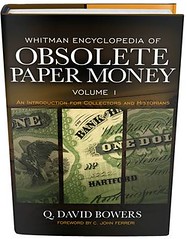 Whitman Publishing announces a call-to-action for all collectors of obsolete paper money to pitch in and help build the best historical and
market reference ever compiled in this field. Collectors, researchers, dealers, historians, and others in the hobby community are encouraged to get
involved with this important project. Images, historical research, market analysis, and general insight are welcome for the Southern states, the
Mid-Atlantic states, the Midwest, and territories.
Whitman Publishing announces a call-to-action for all collectors of obsolete paper money to pitch in and help build the best historical and
market reference ever compiled in this field. Collectors, researchers, dealers, historians, and others in the hobby community are encouraged to get
involved with this important project. Images, historical research, market analysis, and general insight are welcome for the Southern states, the
Mid-Atlantic states, the Midwest, and territories.
In particular, “state editors” for the upcoming states of Alabama, Arkansas, Kentucky, Louisiana, Mississippi, Tennessee, and Texas are sought. Each state editor will work closely with author Dave Bowers, Whitman publisher Dennis Tucker, and Whitman senior associate editor Caitlyn Trautwein to track down facts, look into questions, scrutinize the historical record, gather and examine images, and otherwise act as that state’s expert. Editors have a chance to take a “co-starring role,” as C. John Ferreri has done with the states in New England, and join contributors the likes of the American Bank Note Co., the American Numismatic Society, and the Smithsonian Institution, all of whom (among other museums and private collectors) have shared images. Collectors active in the market of buying, selling, or trading, can volunteer to analyze valuations. Historians with knowledge of a particular state or region can review state, town, and bank histories—fascinating narratives soaked in Americana!
Received with warm welcome at its debut at the Memphis International Paper Money Show in 2014, the Whitman Encyclopedia of Obsolete Paper Money is continuing on strong with five volumes published to date. Within each volume is author Q. David Bowers’ knowledge on obsolete paper money—its history, how to collect it, and observations on the general market, including rarities, supply and demand, and pricing. Volume 1 is an introduction for collectors and historians. Volume 2 studies in detail the states of Connecticut, Maine, and New Hampshire. The two-part Massachusetts volumes, numbering 3 and 4, were released this past winter, and the last volume in the New England region arrived in the spring, comprising of Rhode Island and Vermont. Volume 6 will study Florida, Georgia, North Carolina, and South Carolina as the first volume in the South-Atlantic region and is expected this winter. The monumental study on obsolete currency continues to unfold. The entire series will encompass 15 volumes of 400 to 800 pages each.
Obsolete notes are paper currency issued from 1782 to 1866, before the modern era of National Banks and the Federal Reserve. Over the course of these decades more than 3,000 state-chartered banks released their own paper money for day-to-day commerce, in thousands of colorful and ornate varieties. In the Whitman Encyclopedia of Obsolete Paper Money, each note listed is studied in detail, and thousands are pictured in full color, with information on grading, rarity, values in multiple grades, significant auction results, advice for collectors, and other valuable guidance.
Anyone interested in volunteering can contact Whitman Publishing at obsoletes@whitman.com. Volunteers will be credited in the books’ acknowledgments.
THE BOOK BAZARRE
NEW CONCEPTS IN COINS AND MEDALS: FAD OR FASHION?
Nothing new under the sun?—I strongly disagree for the numismatic field. Mints and medalmakers of the world are outdoing themselves in valiant attempts to create new products for sale to collectors. We have yet to determine whether each of these attempts are fads or fashion.
Ring technology has advanced so far that struck items with planchets of two contrasting metals are now commonplace. No longer a fad. The Paris Mint has even struck a coin of three different metals, one core and two rings of separate color metals.
Adding color to monochromatic coinage metals all of one color has run rampant. Hard enamel, the customary method of adding color to medals and decorations is being replaced by numerous methods. Soft enamels painted on are somewhat now common. We also observe painting each color with organic coatings, or normal paints. Most successful is the technology of “pad printing” by a machine developed by a German firm.
Often any new technology is tried first on a medal before it is adopted for a coin. Proof surface first appeared on a tiny medal before it was adapted for a coin, The U.S. Mint’s new concept of striking a convex-concave blank for the 2014 Baseball Hall of Fame Commemorative coin is not new. Such a blank was used for an earlier American medal, the stunning 3½-inch Society of Medallist issue #122. Creation, by Marcel Jovine. A coin in domed shape is definitely a fad. Such items cannot sustain continuous acceptance by collectors.
Other concepts have been tried in the last two decades -- different shapes including silhouette edges, fabricated items with applied objects like crystal, embedded objects like holograms, fancy edgelettering. The list goes on as mint officials try whatever new gimmick they can conceive. All are fads until they are easy to produce and sustained by wide collector acceptance over years of time.
All this was brought to mind this week as I was writing something about the Federation de la Medaillie (FIDEM), the world group of medallists. In checking their website I found an illustrated list of their biannual congress medals. Presumably one would think these would be the cream of the world’s best in medallic art.
It was dramatic, all were the traditional round shape for the first dozen issues. Only until 1975 when Polish sculptor Jerzy Nowakowsky won the commission to prepare the organization’s medal. Slightly out-of-round it had relief extending beyond the edge on both sides of the design. My goodness! Did his compass slip? While these pieces are customarily cast, they could easily be made any shape other than round.
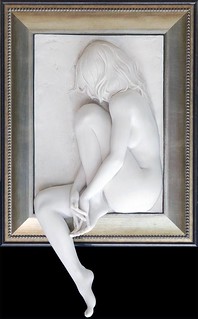 While such “outside the box” design beyond the normal edge is a delight to observe, it is not common. It has a name; such designs are
called “hyperdimensional.” Seasoned sculptor and onetime medallist, Bill Macke, uses this technique frequently. He likes to model female nudes inside
a frame with one leg hanging outside the frame. (If you are not offended by nudes -- this is Art!– go to bas-relief images on the internet,) That’s
really hyperdimensional.
While such “outside the box” design beyond the normal edge is a delight to observe, it is not common. It has a name; such designs are
called “hyperdimensional.” Seasoned sculptor and onetime medallist, Bill Macke, uses this technique frequently. He likes to model female nudes inside
a frame with one leg hanging outside the frame. (If you are not offended by nudes -- this is Art!– go to bas-relief images on the internet,) That’s
really hyperdimensional.
It wasn’t until 1987 at the first American FIDEM congress at ANA in Colorado Springs that another nonround medal was issued. A stunning avant-garde design in oval shape by Mico Kaufman was issued. It was followed by an 8-pointed star shape medal. Then FIDEM reverted back to round again.
At the second American FIDEM congress in 2007, also at ANA, the most creative medal was issued in modified quadrant shape, created by New England sculptor Sarah Peters. It was so unusual four of them could be interconnected together. Since the reverse had the same human design on the reverse, “consimilar,” it could be rearranged in two other configurations. Dramatic!
We can expect the future holds even more wild numismatic specimens as the makers stretch their imaginations for the unusual. Only collectors, however, will determine whether these are fads or not.
I reported on the 2007 FIDEM congress and Sarah Peters’ medal in The E-Sylum volume 10, no. 38, article 9, September 25, 2007.
To read the earlier E-Sylum article, see:
DICK JOHNSON REPORTS FROM THE COLORADO SPRINGS FIDEM CONGRESS
(www.coinbooks.org/esylum_v10n38a09.html)
The FIDEM list of medals is at FIDEM CONGRESS MEDAL ARCHIVES (http://www.fidem-medals.org/congress%20medals%20arc.html).
One Bill Macke relief is at https://s-media-cache-ak0.pinimg.com/originals/22/dc/64/22dc64eab9742a30fd352b077fc22d0c.jpg
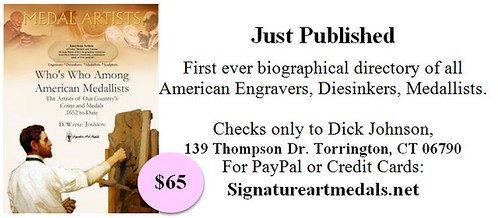
SELECTIONS FROM SINCONA BANKNOTE AUCTION #27
Lot 5034: Imperio do Brasil 1,000 Reis
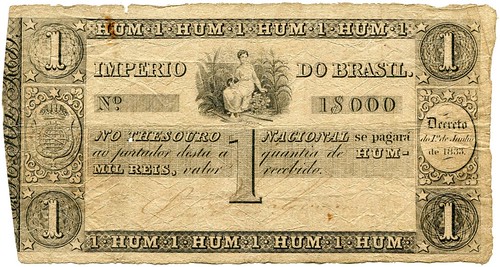
Imperio do Brasil. Thesuoro Nacional. 1 Mil Reis. Decree of 1833. Pick A201.
Lot 5048: British Guyana 1 Dollar
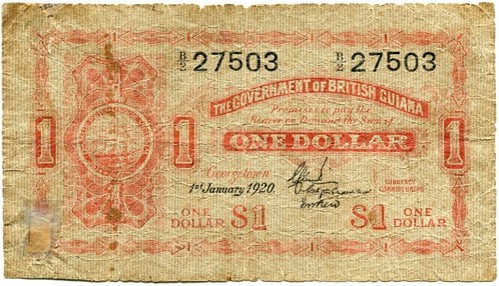
1 Dollar vom 1. Januar 1920. Pick 1A
Lot 5060: Reserve Bank of India 100 Rupees
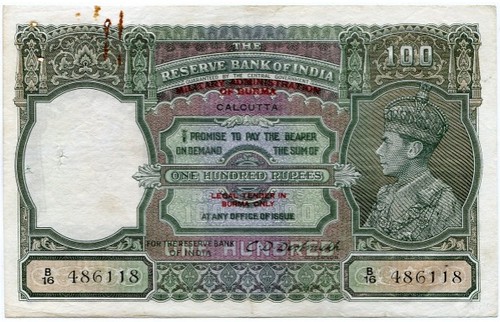
Reserve Bank of India/Military Administration of Burma. 100 Rupien o. J. (1945)
Lot 5082: Central Bank of Manchuko 100 Yuan
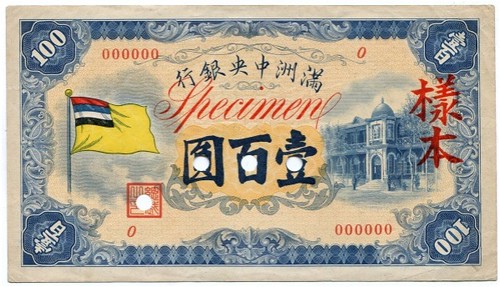
Central Bank of Manchuko 100 Yuan
Lot 5098: Original Package of 5,000 1,000 Mark Notes
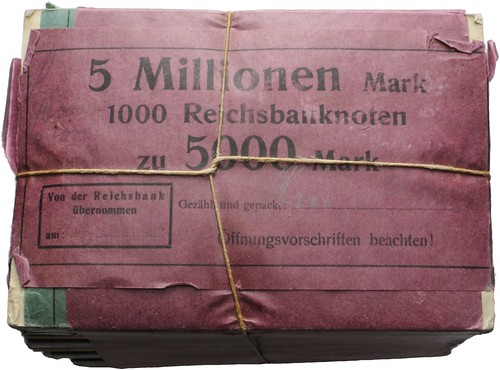
5000 Mark. Originalbund zu 1000 Reichsbanknoten (Betrag 5 Millionen Mark).
Lot 5217: Liberia 1 Dollar 1863

1 Dollar vom 28. Dezember 1863. Pick 6c
To visit the Sincona web site, see:
Sincona Auction 27 - 10.16.2015 09:00 Bank
Notes (https://auktionen.sincona.com/Auktion/Onlinekatalog?lang=en&intAuktionsId=256)
To view the Sincona Auction 27 catalogue, see:
https://www.sincona.com/en/
To read the earlier E-Sylum article, see:
BANKNOTES OF NEW BERN, NORTH CAROLINA
(www.coinbooks.org/esylum_v18n41a13.html)
TWO VIDEOS ON COIN RESTORATION
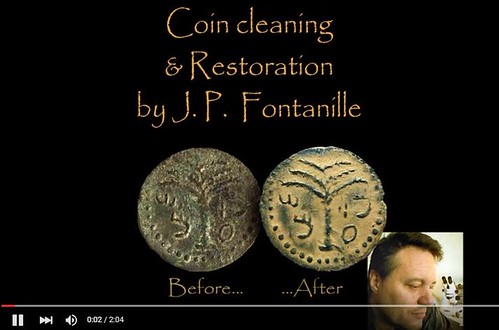
To view the first video, see:
Yehud Type 5 Die Degradation. Music composed & played by JP in
1982 (ttps://www.youtube.com/watch?v=qD7yg3iA9OQ&feature=youtu.be)
To view the second video, see:
Biblical-Judaean coins restoration by J. P. Fontanille - VIDEO 2
(https://www.youtube.com/watch?v=XDtnkc-bCv8&feature=youtu.be)
THE BOOK BAZARRE
HOLLINBECK COIN SHOPS COIN BOARD STAMPS
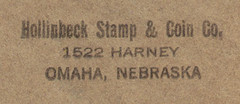

I enjoyed David T. Alexander's article about Art Kagin, and I see that he noted how Art was a big mover of coin boards during the 1930s out of the Hollinbeck coin shops. I'm attaching photos of coin boards in my collection that were rubber stamped by the Omaha and Des Moines stores before sale. This was a way of reminding buyers where to bring their collections when it was time to sell, and it also served as free advertising to potential new customers who viewed their friends' coin boards. I have a few examples of adhesive address labels applied by the Omaha store, but these lack the charm of the rubber stamps.

Also attached is a photo from my coin board book. It's a portrait of Art in one of the shops that also shows a partially filled coin board in the background.

Art Kagin, 1938
Gimbel's Stamp and Coin News Sought
Dave adds:
I also need to make an appeal to readers. I'm looking for a Gimbel's Catalog, also called Gimbel's Stamp and Coin News, from the years 1961 or 1962. I want to see if these issues included ads for the Treasury of Coins line of albums. If anyone has these catalogs with such ads, I'd like to either borrow the catalogs for scanning or get a high resolution scan of the ads.
To read the earlier E-Sylum article, see:
ARTHUR MEYER KAGIN 1919-2005 (www.coinbooks.org/esylum_v18n41a14.html)
REBUS PUZZLE: FORDHAM'S, MONTROSE, PA
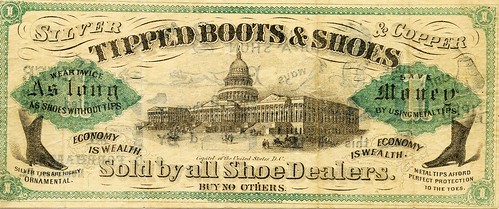


ARCHIE'S PLACE DISPLAYS BANKNOTE COLLECTION
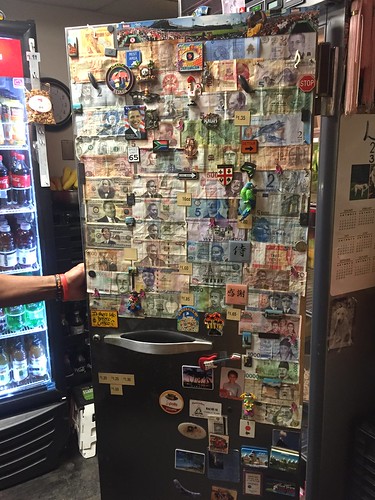 Anne E. Bentley of the Massachusetts Historical Society writes:
Anne E. Bentley of the Massachusetts Historical Society writes:
The Berklee College of Music, our neighbor on Boylston St., is home to Archie's - Archie Brewton caters to an international clientele and his fridge door proves it...
FEATURED WEB PAGE: NUMISMATICA ITALIANA
This week's Featured Web Page is Numismatica Italiana, suggested by John Sallay who writes:It’s in Italian, but you can use Google Translate to see that it’s basically a cooperative effort of dozens of numismatists to catalogue and display tens of thousands of medieval and modern Italian coins and medals (now over 60,000).
It reminds me of Richard’s Token Database (http://tokencatalog.com/). This idea of crowdsourcing a catalogue is an interesting idea, but it will take some time to take hold.

http://numismatica-italiana.lamoneta.it/#
